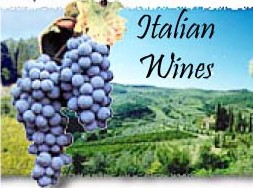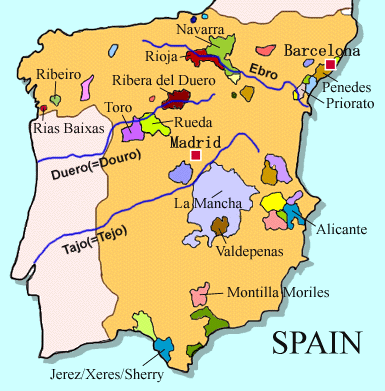2005 Harvest Report - Europe

The
In
the Rheingau Region, steep, well-drained soils fared better than the heavier
clay and loam sites. In the Pfalz Region, the 2005 wines are being hailed as
"fruit bombs”, one of the mad and bad vintages of the last 50 years, and
the acidity is lower than normal.
 There
was much hand wringing in the Italian wine press about the quantity and quality
of this year's vintage. Heavy rains were particularly worrisome in many regions.
Early assessment in the Piedmont region
was for very well-balanced, fresh wines with excellent color and
softness. Obviously, this is not a great year like 1999 or 2001, because the
grapes do not have the same concentrations of sugars and polyphenols. However,
the elegance and drinkability of the 2005 Barolos will satisfy even the most
demanding consumers. Very good marks were awarded to wines made with the
following varietals: Dolcetto, Erbaluce,
Favorita, Nebbiolo and Nebbiolo del Nord Piemonte; and good marks to Moscato
bianco, Barbera, Brachetto, Chardonnay, Cortese, Fresia and Grignolino.
There
was much hand wringing in the Italian wine press about the quantity and quality
of this year's vintage. Heavy rains were particularly worrisome in many regions.
Early assessment in the Piedmont region
was for very well-balanced, fresh wines with excellent color and
softness. Obviously, this is not a great year like 1999 or 2001, because the
grapes do not have the same concentrations of sugars and polyphenols. However,
the elegance and drinkability of the 2005 Barolos will satisfy even the most
demanding consumers. Very good marks were awarded to wines made with the
following varietals: Dolcetto, Erbaluce,
Favorita, Nebbiolo and Nebbiolo del Nord Piemonte; and good marks to Moscato
bianco, Barbera, Brachetto, Chardonnay, Cortese, Fresia and Grignolino.
Producers
throughout the Italian peninsula faced a difficult harvest in 2005. Wet, autumn
weather settled over many regions from the middle of August onward, accompanied
by some heavy downpours and hailstorms, especially in the north. The constantly
damp conditions opened the way for botrytis and other mold, which severely
reduced the quality of the crop.
It
was pretty bad all around for reds but particularly tough for the late-ripening
red varieties. These include Montepulciano in Abruzzo and Aglianico in the
southern regions. Earlier-ripening varieties, such as Merlot and Syrah were
better able to fully ripen for the harvest, despite the rain.
The
Piedmont Region:
After
a summer of unpredictable weather, the outcome of the harvest in
The
In
general, it was not a great year for
The
quality of Sangiovese was very uneven in the Chianti Classico area. Vineyards in
higher altitudes, with better drainage and better ventilation, had more chance
to offset the effects of the damp weather. On the whole, the coastal areas
performed better than the interior. The Cabernet and Merlot are very good
quality and the Sangiovese fared better in the warm areas further down the
coast, where grapes can ripen at least a week earlier than in other parts of
In
Montalcino, home to Brunello di Montalcino, the area south of town fared better
than the cooler northern area. The Sangiovese that made it to the winery was
good quality, but a high percentage of fruit was left on the vine. Some of the
grapes just didn't ripen, and there was botrytis in many of the vineyards.
 Drought
conditions plagued wide sections of
Drought
conditions plagued wide sections of
Despite
the stress of the drought, the vines were healthy. Four days of steady rain in
September also helped to perk them up before harvest. After this rain, the
region had a sunny, dry harvest with some cool nights and even some dew. The
resulting wines are showing good color and aromas, though it was hard to gauge
overall quality because the wines are just in their infancy.
While
the vines were indeed stressed by drought, low humidity suppressed the incidence
of disease in the vineyards. Some very fine, elegant wines with good acidity and
a lot of personality have been made, especially those sourced from cooler north-
and east-facing vineyards on higher ground.
 Dry,
hot weather caused an early harvest of 10 days ahead of schedule. Drought
conditions in some regions resulted in less fruit, but with good concentration
and quality. An excellent vintage was declared by Rias Baixas, Navarra, Rueda
and Toro and very good vintage was declared by Priorat,
Dry,
hot weather caused an early harvest of 10 days ahead of schedule. Drought
conditions in some regions resulted in less fruit, but with good concentration
and quality. An excellent vintage was declared by Rias Baixas, Navarra, Rueda
and Toro and very good vintage was declared by Priorat,
One
of the driest years in memory led to yields that are 10 percent to 40 percent
lower than normal in some vineyards. Although summer was marked by a drought,
temperatures were not overly warm. The result was a crop of small, concentrated
grapes that were able to ripen fully, free of mildew or mold. Many winemakers
believe they will make good to outstanding wines, especially among the reds.
In
Ribera del Duero, a September frost burned the vine leaves and deprived the
grapes of shade. Nonetheleess, Tempranillo is expected to have a lot of color,
mature tannins and well-balanced acidity.
In
the Catalonian winegrowing areas, the dry spell was relieved by intense rainfall
on Sept. 7 and 8. The soil totally absorbed the water, and botrytis did not
form. Afterward, the weather was mild and dry, allowing the grapes to reach
excellent phenolic maturity.
 The
summer had good weather during the day and fresh nights, which supported the
flavors; the grapes have a thick skin and are very healthy. The rains at the
beginning of September did not affect the quality of the grapes but allowed a
better maturity. The North wind blowing during the grape harvest accelerated the
concentration. In general the wines show extremely intense fruity flavors and
very dense colors, all the ingredients necessary to create a year of very good
quality.
The
summer had good weather during the day and fresh nights, which supported the
flavors; the grapes have a thick skin and are very healthy. The rains at the
beginning of September did not affect the quality of the grapes but allowed a
better maturity. The North wind blowing during the grape harvest accelerated the
concentration. In general the wines show extremely intense fruity flavors and
very dense colors, all the ingredients necessary to create a year of very good
quality.
The
Initial reports say
Burgundy 2005 is set to be a great harvest quality-wise. Some commentators are
even saying that this year's
The grape bunches on both Chardonnay and Pinot Noir are well formed and getting
plenty of air. They are exceptionally healthy and the vines have escaped any
and all infections. A characteristic of this year's Pinot Noir is the thickness
of its skins – a pointer to color and structure in the wines. The grapes are
already high in sugar and the sugar/acidity balance is excellent for fruit at
this stage in maturation.
The region as a whole has
experienced good weather conditions throughout the summer with mostly dry, sunny
days and cool nights. Rain fell across the region on August 19, bringing the
water table up when drought was threatening the vines. The rain came at just the
right moment and all the conditions for a great vintage are coming together.
Like most of
The
2005 has been proclaimed an
“Exceptional Year.” Cool nights and warm days toward the end of summer meant
ideal conditions in the vineyard resulting in balanced grapes, both red and
white varieties, of remarkable quality, liveliness, both flavorful and rich. For
reds, Left and
Sauvignon Blanc:
2005 has proved to be a noteworthy year for Sauvignon Blanc. Weather during the
last two weeks of August played a key role in the development of this grape,
leading to beautiful aromatics and balanced maturity, acidity, and freshness —
perfect for dry white wines of great quality.
Semillon: Crisp September nights paired with heat during the
day supported the development of botrytis, essential for the development of the
signature sweet
Merlot and Malbec: With smaller than average berry-size due to
dry weather and other climate conditions, the Merlot and Malbec reached optimum
brix levels. Color extraction is aided by highly concentrated anthocyanins,
(the organic compounds responsible for the rich, purple-red, color of the
grapes and resulting wines). Based on initial tastings during fermentation,
opinions are positive, and the potential is generally agreed to be remarkable.
Cabernet Franc and Cabernet Sauvignon: These later-developing
varieties profited from dry conditions and achieved full physiological
ripeness. They exhibit the rare balance between sugar, tannin, and flavor,
ultimately expressing the classic qualities of "

Information and tips for finding end enjoying everyday wines from Europe and other major wine regions:
Search the Blogs
Copyright WineNews.com 2009

